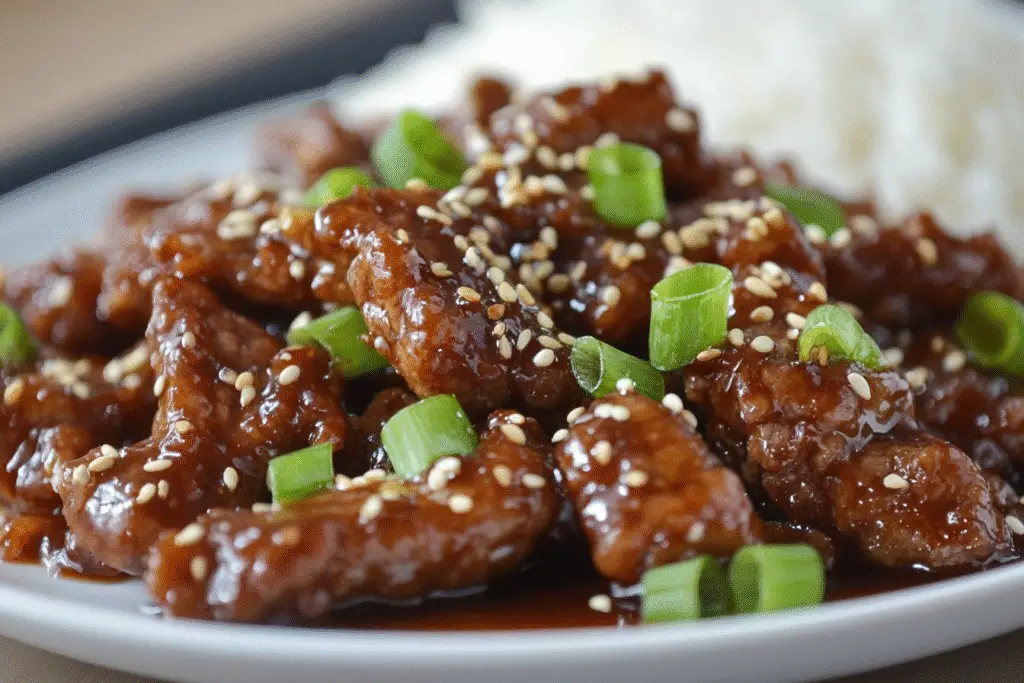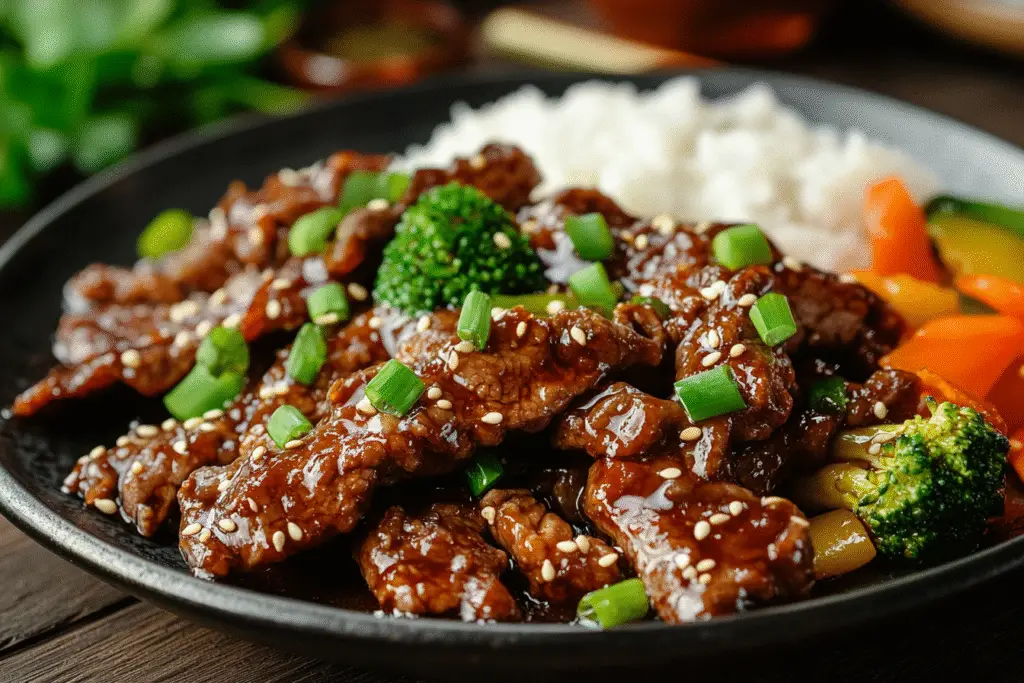Ginger beef is a beloved dish that originated in Western Canada’s Chinese restaurants, particularly in Calgary, and has since gained popularity as a crispy, sticky, sweet, and spicy beef stir-fry. It’s known for its thinly sliced, crispy fried beef strips coated in a glossy ginger-infused sauce that perfectly balances savory, sweet, and spicy flavors.
Unlike traditional Chinese stir-fries that emphasize tenderness, ginger beef delivers a satisfying crispiness while still being coated in sauce. The secret is in double-frying the beef to achieve a shatteringly crisp texture and building a sauce that’s rich with fresh ginger, soy, garlic, and a touch of sugar.
This step-by-step Ginger Beef Recipe will guide you through selecting the best cut of beef, creating a light batter for frying, crafting the perfect sauce, and achieving restaurant-quality crispness and flavor at home.
Why Ginger Beef Can Be Challenging: Common Mistakes and How to Avoid Them
Ginger beef seems simple but can easily go wrong:
- Soggy beef: Happens when the oil isn’t hot enough or when the sauce is added too soon.
- Chewy or overcooked beef: Occurs if the beef is sliced too thick or fried too long.
- Sauce that’s too thin or too thick: Requires proper balance of cornstarch and reduction timing.
- Beef that loses crispness: Sauce was too watery or beef sat too long before serving.
Keys to Success:
- Slice beef thinly and against the grain.
- Double-fry the beef for ultimate crispness.
- Coat the beef quickly in the sauce right before serving to maintain texture.
- Build a balanced sauce with soy, ginger, garlic, sugar, and vinegar.

Selecting the Best Ingredients for Ginger Beef
Beef Selection
- Flank Steak or Sirloin: Tender, quick-cooking, and slices thinly.
- Avoid: Tough cuts like chuck or cuts with lots of connective tissue.
Tip: Freeze the beef for 20–30 minutes before slicing for easier, thinner cuts.
Sauce Components
- Fresh Ginger: The star of the dish—provides sharpness and aroma.
- Soy Sauce: Adds savory umami.
- Rice Vinegar or White Vinegar: Balances sweetness.
- Sugar or Honey: For the signature sticky glaze.
- Garlic, Red Pepper Flakes, and Sesame Oil: For added depth and heat.
Batter Ingredients
- Cornstarch and a light egg coating ensure crispy beef.
- Water or a splash of soy sauce can be added to loosen the batter if needed.
Essential Equipment
- Wok or large skillet: Needed for stir-frying and quickly tossing the beef.
- Deep pot or pan: For frying the beef strips.
- Wire rack or paper towels: For draining fried beef.
- Tongs or chopsticks: For safely handling beef during frying.
Smart Preparation Tips
Prep Timeline:
- Beef marination: ~10-15 minutes
- Frying: ~15-20 minutes
- Sauce and final stir-fry: ~5 minutes
Key Prep Tips:
- Always have all sauce ingredients pre-measured before you begin frying.
- Fry in small batches to maintain oil temperature.
- Toss beef in the sauce quickly right before serving to retain crispness.

Flavor Variations and Customizations
- Spicier: Add sliced fresh chilies or more red pepper flakes.
- Sweeter: Increase sugar or drizzle with honey.
- Vegetable Additions: Stir-fry with bell peppers, carrots, or scallions for added crunch.
- Sauce Twist: Add a tablespoon of hoisin sauce for richer depth.
Protein Alternatives:
- Thinly sliced chicken or pork can replace beef using the same batter and technique.
- For a vegetarian version, crispy fried tofu or mushrooms can work well.
Common Mistakes and How to Fix Them
- Soggy Beef: Oil wasn’t hot enough or beef sat too long in sauce. Ensure proper frying temperature (350°F/175°C) and toss with sauce just before serving.
- Beef Chewy: Sliced too thick or over-fried. Always cut thinly against the grain.
- Greasy Texture: Oil temperature dropped too low. Fry in batches to maintain heat.
- Sauce Too Thin: Simmer sauce briefly to reduce or add a small cornstarch slurry.
Storage, Freezing, and Reheating Tips
- Storage: Best served fresh, but can store in the fridge for up to 2 days. Beef will soften as it sits in the sauce.
- Freezing: Not recommended as crispy texture will be lost.
- Reheating: Reheat in a hot skillet to help restore some crispness, but freshly made is far superior.
Ginger Beef Recipe
Ingredients
For the Crispy Beef:
- ¾ pound flank steak or sirloin, thinly sliced against the grain
- ¼ cup cornstarch
- 1 large egg
- ½ teaspoon soy sauce
- Vegetable oil, for frying
For the Sauce:
- 3 tablespoons soy sauce
- 2 tablespoons rice vinegar (or white vinegar)
- 3 tablespoons sugar
- 1 tablespoon oyster sauce (optional)
- 2 teaspoons sesame oil
- 2 tablespoons fresh ginger, finely minced
- 2 cloves garlic, minced
- ½ teaspoon red pepper flakes (adjust to taste)
- ½ cup water
- 1 teaspoon cornstarch mixed with 1 tablespoon water (slurry)
Optional Garnishes:
- Sliced green onions
- Toasted sesame seeds
- Steamed rice
Step-by-Step Instructions
Step 1: Prepare the Beef
- In a bowl, whisk egg and soy sauce. Add beef strips and toss to coat.
- Sprinkle cornstarch over the beef and toss until evenly coated.
Step 2: Fry the Beef
- Heat 2 inches of oil in a deep skillet or pot to 350°F (175°C).
- Fry beef strips in small batches for 2-3 minutes until lightly golden.
- Drain on a wire rack or paper towels.
- For extra crispness, refry all beef strips for another 1-2 minutes in hot oil.
Step 3: Make the Sauce
- In a separate small bowl, combine soy sauce, vinegar, sugar, oyster sauce (if using), sesame oil, and water. Set aside.
- Heat a wok or large skillet over medium heat.
- Add a tablespoon of oil and sauté minced ginger, garlic, and red pepper flakes for about 30 seconds until fragrant.
- Pour in the sauce mixture and bring to a simmer.
- Stir in cornstarch slurry and cook for 1-2 minutes until the sauce thickens to a glossy glaze.
Step 4: Toss the Beef
- Add crispy beef to the sauce.
- Toss quickly to coat all beef strips evenly in the sticky sauce.
- Remove from heat immediately.
Step 5: Serve
- Garnish with green onions and sesame seeds.
- Serve hot with steamed rice.
Serving Suggestions
- Classic: Served over steamed white rice or jasmine rice.
- With sides: Pair with stir-fried vegetables, fried rice, or crispy spring rolls.
- With noodles: Toss beef and sauce with lo mein noodles for a delicious twist.
Ginger Beef Variations: Classic vs. Sweet vs. Spicy
| Feature | Classic Ginger Beef | Sweet Version | Spicy Version |
|---|---|---|---|
| Sauce Base | Soy, sugar, ginger | Extra sugar, honey | More red pepper, fresh chilies |
| Texture | Crispy, sticky | Slightly thicker glaze | Sticky with chili heat |
| Vegetables | Optional garnish | Often includes bell peppers | Often includes scallions or chilies |
FAQs and Troubleshooting
Can I use a different cut of beef?
Yes, but flank steak or sirloin work best. Avoid tough cuts like chuck.
How do I keep the beef crispy?
Double-frying is key, and only toss with sauce right before serving.
Can I make this gluten-free?
Yes. Use gluten-free soy sauce and check labels on oyster sauce.
Can I make this ahead?
The sauce can be made in advance, but the beef should be fried fresh for best texture.
What’s the best oil for frying?
Vegetable oil, canola oil, or peanut oil—all with high smoke points.
Final Thoughts
Ginger beef is a crispy, sweet, and savory dish that brings the joy of takeout right into your kitchen. With its perfectly fried beef strips, bold ginger-infused sauce, and balanced sweet-spicy profile, it’s a dish that’s both fun to make and incredibly satisfying to eat.
By following this detailed step-by-step guide, you can confidently create restaurant-quality ginger beef at home, customize it to your preferred spice level, and impress family and friends with this irresistible, crispy, sticky, and delicious classic.
